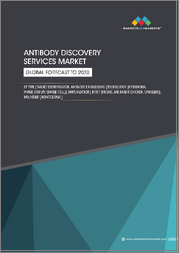
|
시장보고서
상품코드
1663168
단세포 단백질 시장 규모, 점유율, 성장 분석 : 공급원별, 원료별, 용도별, 지역별 - 산업 예측(2025-2032년)Single Cell Protein Market Size, Share, and Growth Analysis, By Source (Bacteria, Yeast), By Feedstock (Organic, Conventional), By Application, By Region - Industry Forecast 2025-2032 |
||||||
단세포 단백질 시장 규모는 2023년에 103억 6,000만 달러로, 2024년 112억 9,000만 달러에서 2032년에는 225억 달러로 성장하며, 예측 기간(2025-2032년)의 CAGR은 9.0%로 성장할 전망입니다.
세계 단세포 단백질 시장은 식품, 사료, 산업 분야에서 지속가능한 대체 단백질 공급원에 대한 수요가 증가함에 따라 크게 성장하고 있습니다. 영양가가 높고 환경에 미치는 영향이 적은 미생물 유래 단세포 단백질이 인기를 끌고 있습니다. 생명공학 및 발효 공정의 기술 발전으로 단백질 수율과 비용 효율성이 향상되고, 균주 엔지니어링 및 바이오리액터 설계의 혁신으로 확장성이 향상되고 있습니다. 주요 시장 성장 촉진요인으로는 규제 장벽과 대중의 수용성 우려에도 불구하고 인구 증가, 자원 제약, 식습관 선호도 변화 등을 들 수 있습니다. 이 분야에 대한 연구와 투자가 증가함에 따라 단일 세포 단백질은 세계 식량안보와 단백질 수요 증가라는 과제를 해결하는 데 중요한 역할을 하게 될 것입니다.
목차
서론
- 조사의 목적
- 조사 범위
- 정의
조사 방법
- 정보 조달
- 2차와 1차 데이터 방법
- 시장 규모 예측
- 시장의 전제조건과 제한
개요
- 세계 시장 전망
- 공급과 수요 동향 분석
- 부문별 기회 분석
시장 역학과 전망
- 시장 개요
- 시장 규모
- 시장 역학
- 촉진요인과 기회
- 억제요인과 과제
- Porter의 산업 분석
주요 시장 인사이트
- 주요 성공 요인
- 경쟁의 정도
- 주요 투자 기회
- 시장 에코시스템
- 시장의 매력 지수(2024년)
- PESTEL 분석
- 거시경제 지표
- 밸류체인 분석
- 가격 분석
단세포 단백질 시장 규모 : 공급원별 & CAGR(2025-2032)
- 시장 개요
- 세균
- 효모
- 조류
- 클로렐라
- 스피룰리나
- Haematococcus
- 기타
- 균류
단세포 단백질 시장 규모 : 원료별 & CAGR(2025-2032)
- 시장 개요
- 유기
- 기존형
단세포 단백질 시장 규모 : 용도별 & CAGR(2025-2032)
- 시장 개요
- 식품 및 음료
- 대체육
- 베이커리
- 유제품 대체품
- 시리얼 & 스낵
- 음료
- 기타
- 동물 사료
- 가금
- 브로일러
- 레이어
- 칠면조
- 기타
- 돼지
- 스타터
- 그로워
- 암퇘지
- 소
- 유제품
- 송아지
- 기타
- 양식업
- 연어
- 송어
- 새우
- 잉어
- 기타
- 애완동물 사료
- 개
- 고양이
- 조류
- 어류
- 말
- 기타
- 식이보충제
- 기타
단세포 단백질 시장 규모 : 지역별 & CAGR(2025-2032)
- 북미
- 미국
- 캐나다
- 유럽
- 독일
- 스페인
- 프랑스
- 영국
- 이탈리아
- 기타 유럽 지역
- 아시아태평양
- 중국
- 인도
- 일본
- 한국
- 기타 아시아태평양
- 라틴아메리카
- 브라질
- 기타 라틴아메리카 지역
- 중동 및 아프리카
- GCC 국가
- 남아프리카공화국
- 기타 중동 및 아프리카
경쟁 정보
- 상위 5사의 비교
- 주요 기업의 시장 포지셔닝(2024년)
- 주요 시장 기업이 채택한 전략
- 최근 시장 동향
- 기업의 시장 점유율 분석(2024년)
- 주요 기업의 기업 개요
- 기업의 상세
- 제품 포트폴리오 분석
- 기업의 부문별 점유율 분석
- 매출의 전년대비 비교(2022-2024)
주요 기업 개요
- Calysta(United States)
- Solar Foods(Finland)
- Remilk(Israel)
- Beyond Meat(United States)
- Ventria Bioscience(United States)
- Unibio(Denmark)
- Allmicroalgae(Portugal)
- KnipBio(United States)
- Sophie's Bionutrients(Singapore)
- AlgaEnergy(Spain)
- Corbion(Netherlands)
- Algatechnologies(Israel)
- Heliae Development(United States)
- Spirulina Company(India)
- Algalif(Iceland)
- Cellana(United States)
- Cyanotech Corporation(United States)
- AlgaeCytes(United Kingdom)
결론과 제안
KSA 25.04.01Single Cell Protein Market size was valued at USD 10.36 billion in 2023 and is poised to grow from USD 11.29 billion in 2024 to USD 22.5 billion by 2032, growing at a CAGR of 9.0% during the forecast period (2025-2032).
The global single-cell protein market is experiencing significant growth, driven by the rising demand for sustainable and alternative protein sources across food, feed, and industrial sectors. With high nutritional value and low environmental impact, single-cell protein derived from microorganisms is gaining traction. Technological advancements in biotechnology and fermentation processes have enhanced protein yields and cost-effectiveness, while innovations in strain engineering and bioreactor designs have improved scalability. Key market drivers include a growing population, resource limitations, and evolving dietary preferences, despite regulatory hurdles and public acceptance concerns. As research and investment in this sector increase, single-cell protein is positioned to play a vital role in addressing global food security and the increasing protein demand challenges.
Top-down and bottom-up approaches were used to estimate and validate the size of the Single Cell Protein market and to estimate the size of various other dependent submarkets. The research methodology used to estimate the market size includes the following details: The key players in the market were identified through secondary research, and their market shares in the respective regions were determined through primary and secondary research. This entire procedure includes the study of the annual and financial reports of the top market players and extensive interviews for key insights from industry leaders such as CEOs, VPs, directors, and marketing executives. All percentage shares split, and breakdowns were determined using secondary sources and verified through Primary sources. All possible parameters that affect the markets covered in this research study have been accounted for, viewed in extensive detail, verified through primary research, and analyzed to get the final quantitative and qualitative data.
Single Cell Protein Market Segments Analysis
Global Single Cell Protein Market is segmented by Source, Feedstock, Application and region. Based on Source, the market is segmented into Bacteria, Yeast, Algae and Fungi. Based on Feedstock, the market is segmented into Organic and Conventional. Based on Application, the market is segmented into Food & Beverage, Animal Feed, Dietary Supplements and Others. Based on region, the market is segmented into North America, Europe, Asia Pacific, Latin America and Middle East & Africa.
Driver of the Single Cell Protein Market
The ongoing rise in the global population is significantly boosting the need for food and protein sources, which in turn propels the demand for single-cell protein. This innovative protein alternative presents an effective solution to address the escalating food needs, thanks to its superior resource efficiency and quicker production rates compared to conventional livestock farming methods. As the pressure to find sustainable and scalable protein sources heightens, single-cell protein emerges as a promising option, capable of delivering the necessary nutrients while minimizing environmental impact, thus positioning itself as a key driver in the ever-evolving food market landscape.
Restraints in the Single Cell Protein Market
The single-cell protein market may encounter significant obstacles due to regulatory challenges, especially concerning safety evaluations and labeling requirements. Regulatory bodies are likely to mandate comprehensive assessments to verify the safety of these innovative protein sources for both human and animal consumption. These stringent regulations could slow down the production process and complicate market entry, potentially limiting the growth of single-cell protein adoption. As the industry develops, navigating these regulatory landscapes will be crucial for manufacturers, who must ensure compliance while also addressing consumer concerns about the safety and labeling of such novel food sources.
Market Trends of the Single Cell Protein Market
The Single Cell Protein (SCP) market is witnessing a robust upward trend, driven by escalating consumer awareness of sustainability and the search for alternative protein sources amid rising global protein demands. As environmental concerns regarding traditional livestock farming intensify, SCP, derived from microorganisms like bacteria, yeast, fungi, and algae, emerges as a viable solution. These proteins not only require fewer resources for cultivation but also exhibit a significantly lower environmental footprint compared to conventional animal proteins. This shift towards SCP is fueled by innovations in biotechnology and an expanding application scope in food products, thus solidifying its position in the protein market landscape.
Table of Contents
Introduction
- Objectives of the Study
- Scope of the Report
- Definitions
Research Methodology
- Information Procurement
- Secondary & Primary Data Methods
- Market Size Estimation
- Market Assumptions & Limitations
Executive Summary
- Global Market Outlook
- Supply & Demand Trend Analysis
- Segmental Opportunity Analysis
Market Dynamics & Outlook
- Market Overview
- Market Size
- Market Dynamics
- Drivers & Opportunities
- Restraints & Challenges
- Porters Analysis
- Competitive rivalry
- Threat of substitute
- Bargaining power of buyers
- Threat of new entrants
- Bargaining power of suppliers
Key Market Insights
- Key Success Factors
- Degree of Competition
- Top Investment Pockets
- Market Ecosystem
- Market Attractiveness Index, 2024
- PESTEL Analysis
- Macro-Economic Indicators
- Value Chain Analysis
- Pricing Analysis
Global Single Cell Protein Market Size by Source & CAGR (2025-2032)
- Market Overview
- Bacteria
- Yeast
- Algae
- Chlorella
- Spirulina
- Haematococcus
- Others
- Fungi
Global Single Cell Protein Market Size by Feedstock & CAGR (2025-2032)
- Market Overview
- Organic
- Conventional
Global Single Cell Protein Market Size by Application & CAGR (2025-2032)
- Market Overview
- Food & Beverage
- Meat Analogs
- Bakery
- Dairy Alternatives
- Cereals & Snacks
- Beverages
- Others
- Animal Feed
- Poultry
- Broiler
- Layer
- Turkey
- Others
- Swine
- Starter
- Grower
- Sow
- Cattle
- Dairy
- Calf
- Others
- Aquaculture
- Salmon
- Trout
- Shrimp
- Carp
- Others
- Pet Food
- Dogs
- Cats
- Birds
- Fish
- Equine
- Others
- Dietary Supplements
- Others
Global Single Cell Protein Market Size & CAGR (2025-2032)
- North America (Source, Feedstock, Application)
- US
- Canada
- Europe (Source, Feedstock, Application)
- Germany
- Spain
- France
- UK
- Italy
- Rest of Europe
- Asia Pacific (Source, Feedstock, Application)
- China
- India
- Japan
- South Korea
- Rest of Asia-Pacific
- Latin America (Source, Feedstock, Application)
- Brazil
- Rest of Latin America
- Middle East & Africa (Source, Feedstock, Application)
- GCC Countries
- South Africa
- Rest of Middle East & Africa
Competitive Intelligence
- Top 5 Player Comparison
- Market Positioning of Key Players, 2024
- Strategies Adopted by Key Market Players
- Recent Developments in the Market
- Company Market Share Analysis, 2024
- Company Profiles of All Key Players
- Company Details
- Product Portfolio Analysis
- Company's Segmental Share Analysis
- Revenue Y-O-Y Comparison (2022-2024)
Key Company Profiles
- Calysta (United States)
- Company Overview
- Business Segment Overview
- Financial Updates
- Key Developments
- Solar Foods (Finland)
- Company Overview
- Business Segment Overview
- Financial Updates
- Key Developments
- Remilk (Israel)
- Company Overview
- Business Segment Overview
- Financial Updates
- Key Developments
- Beyond Meat (United States)
- Company Overview
- Business Segment Overview
- Financial Updates
- Key Developments
- Ventria Bioscience (United States)
- Company Overview
- Business Segment Overview
- Financial Updates
- Key Developments
- Unibio (Denmark)
- Company Overview
- Business Segment Overview
- Financial Updates
- Key Developments
- Allmicroalgae (Portugal)
- Company Overview
- Business Segment Overview
- Financial Updates
- Key Developments
- KnipBio (United States)
- Company Overview
- Business Segment Overview
- Financial Updates
- Key Developments
- Sophie's Bionutrients (Singapore)
- Company Overview
- Business Segment Overview
- Financial Updates
- Key Developments
- AlgaEnergy (Spain)
- Company Overview
- Business Segment Overview
- Financial Updates
- Key Developments
- Corbion (Netherlands)
- Company Overview
- Business Segment Overview
- Financial Updates
- Key Developments
- Algatechnologies (Israel)
- Company Overview
- Business Segment Overview
- Financial Updates
- Key Developments
- Heliae Development (United States)
- Company Overview
- Business Segment Overview
- Financial Updates
- Key Developments
- Spirulina Company (India)
- Company Overview
- Business Segment Overview
- Financial Updates
- Key Developments
- Algalif (Iceland)
- Company Overview
- Business Segment Overview
- Financial Updates
- Key Developments
- Cellana (United States)
- Company Overview
- Business Segment Overview
- Financial Updates
- Key Developments
- Cyanotech Corporation (United States)
- Company Overview
- Business Segment Overview
- Financial Updates
- Key Developments
- AlgaeCytes (United Kingdom)
- Company Overview
- Business Segment Overview
- Financial Updates
- Key Developments



















